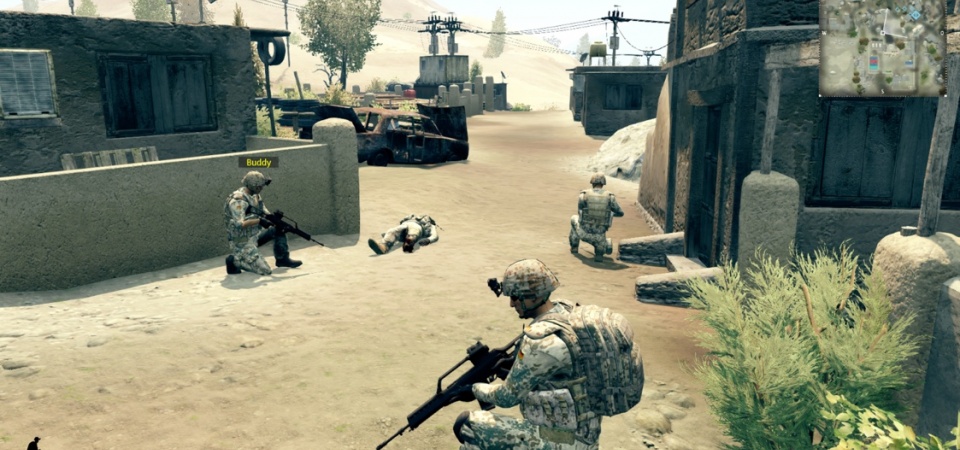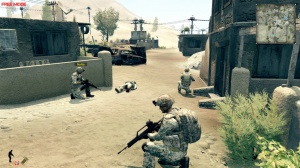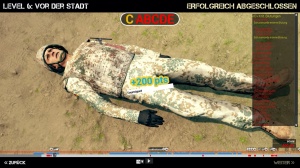

Article: L . Schneidereit, R .U. Hübner, Th. Gebhardt, M. Pietraß, Sh. Berger, M. Hofmann, A. Lehmann, C. Küsel
Digital Training Projects of the Bundeswehr Medical Service
An integrative learning concept
Highly trained medical and military personnel is essential for military organizations to face today’s and future challenges as well as to react to newly arising risks confidently. This is especially true for military organizations facing today’s global highly dynamic threat scenarios, spanning from terrorist attacks, civil medical support, disaster management and relief to global conflicts.
In 2022-2024, the Bundeswehr will provide a brigade for NRF (NATO Response Force) with VJTF (Very High Readiness Joint Task Force) in the 2023 focal point. The medical service will contribute to the medical care of the operational unit with personnel in the size of a battalion, which requires the personnel and material resources of 1-2 medical regiments in the background. Until 2032, ten brigades are assured within the NRF/VJTF framework, of which a third is partially active, i.e. will be provided by reserve service personnel. The personnel requirements calculation, which derives the conclusions for the Bundeswehr Medical Service, is not rocket science at this point.
With currently three active medical regiments, one in constitution and Rapid Medical Response Forces Regiment as regimental equivalent in a special role, there is a clear need for personnel and training. Irrespective of this calculation, further operational obligations and the provision of health care for the entire Bundeswehr will continue to exist during the NRF.
An ever-increasing specialization in the medical professions combined with a simultaneous shortage of instructors logically leads to an expansion of training requirements and a focus on competence- oriented training. The skills acquired in turn make it essential to maintain qualifications and continuous further training. Due to the growing demand, reserve personnel will play an increasingly important role in the armed forces of the future. Since they have a civilian profession and have duties to fulfil, the armed forces will have to provide an alternative educational concept. A lack of teaching staff in combination with increasing demand and a lack of time and space will lead to the implementation of alternative forms of training that will enable learners to take advantage of training opportunities independent of central learning locations.
Last but not least, the corona pandemic is currently forcing the Bundeswehr Medical Service to put the necessary transformation process into practice faster than planned, since face-to-face training courses with many soldiers on site will only be possible with considerable restrictions in the foreseeable future. The first projects in this direction are already being carried out in the context of digitizing parts of the general basic training and career courses. Further content, for example in language training or basic medical skills for all soldiers, can be digitized in the short term.
In the medium term, there is no way around implementing a distance learning component in every training course within the Central Medical Service of the Bundeswehr in order to be able to react flexibly to changing requirements in terms of personnel and structure.
An important guiding principle here must be a combined solution for the German Armed Forces that also integrates existing competence-oriented training concepts in a flexible and scalable manner and reliably prepares trainees for certified examinations. Training is key to live up to today’s military and medical challenges. Digitization therefore provides a chance to improve and support medical training and to save resources. Due to its pivotal position, the Bundeswehr Medical Service can be seen as a key player for digitization in addition to its universal impact on all operations and missions leading to a high and ever-increasing training demand that needs to be faced.
Digitization in Military Medical Training
 Realistic, tactical level design is a relevant aspect of the Serious Game SanTrain
Realistic, tactical level design is a relevant aspect of the Serious Game SanTrain
The Military medical service fulfills a special role within military organizations, as it is part of and provides professional medical training to any other military unit. Given it has to cover all possible medical scenarios, ranging from simple to critical injuries including armed conflict specific injuries as well as special threat scenarios such as CBRN situations, the military medical service has to offer a multitude of training courses. In general, training exercises require a large amount of resources, organization and personnel. These demands put the military medical service in a pioneering role employing the newly arising possibilities and capabilities of digitization to improve and expand the training that is offered while also increasing resource efficiency. The independency of time and location as digitization’s inherent properties lead to an increased training intensity, reduction in trainee attendance time and improved adaptivity to new demands and arising challenges. This gain in adaptivity provides a dynamic framework to support alliance cooperation, allowing the military medical service to quickly adjust their training to new requirements of quickly evolving conflicts and political situations.
Compared to military operations and military medical medicine, in modern civilian clinical everyday life, training and education in hospitals are crucial to supporting and enabling the increased demand for individual medical care quality and cost-efficiency. In order to support training, simulation devices range from parttask trainers to full-scale simulations. Even though technology advances at a rapid pace, there always remains a certain degree of abstractness within the training and education sessions. This can include missing (patho-)physiological effects within simulations or missing details in the training setting itself, such as communications with the team. Moreover, the skill-trainer technology, especially for haptic skillsets, is normally bound to certain locations, such as simulation centers, and not available on demand (Hauer et al., 2019; Willy, 2019). Digitization can alleviate these deficits by providing training and education solutions available at any time to train on, improving efficiency and reducing idleness, given the solution has been hand-tailored to meet the specific target group’s requirements and preferences.
Digital Training for the Bundeswehr Medical Service
San-Netz: An Online Learning Platform
Local and device-independent communication while protecting all content from unauthorized third-party access is becoming increasingly the standard in modern companies, especially in the field of training. In this context, the San-Netz is a central network and training platform for members of the Bundeswehr Medical Service. In contrast to the Bundeswehr’s intranet, it allows authorized users exactly this device-independent use over the Internet. It thus enables a professional exchange on business trips, deploying an interface optimized for mobile devices, or from the home office. The user statistics at the end of 2018 show that this tool is mainly used by medical officers (SanStOffz) and medical officer candidates (SanOA). The SanOA is conducting his medical studies and usually does not have access to official Bundeswehr work computers or laptops and thus can make full use of the device independent access possibilities. The San-Netz is ever expanding and content is well received by the registered members.
This platform consists of a multitude of different applications, learning opportunities, knowledge bases and possibilities for interactivity among its users:
• E-campus: It offers San-Netz users numerous variants of education and training and provides the base for all the different offers.
• Virtual library: It is possible to research in the virtual library with free access to multiple specialist journals, books and essays. Furthermore, there is the option to order specific literature easily.
• DynaMed Plus: More than 1.5 billion bibliographical data sets are currently available via this database for medical professionals. This database is updated daily and allows users to quickly get the latest information on diagnoses, diseases and treatment options.
• GIDEON: The Global Infectious Disease and Epidemiological Network (GIDEON) is an online database with focus on epidemiology. It features endemicity maps, laboratory findings and therapy notes among many other data points.
• CNE.online: is a virtual training concept designed specifically for health and nursing care. It is possible to earn CNE (Certified Nursing Education) training points that provide evidence of training.
• ILIAS: is a learning platform that offers various courses for independent continuing education.
• The “Virtual Clinic”: is an internet-based learning and information system for medical education and training. Real or realistic civil and operationally relevant studies are processed. It is possible to train in learning mode or to work on Continuing Medical Education (CME) mode to obtain CME points to prove training. These CME points have been mandatory for specialists since 2004 in Germany.
• eRef: The eRef service provides access to various e-journals and e-books of Thieme in all relevant medical disciplines. This knowledge portal of Thieme supports the findings, research, as well as the training and further education, allowing additional acquisition of CME points.
• Via Medici: is a newly added program. It supports medical students throughout their entire medical studies by using it to prepare for their exams. Because of its modular and flexible design, it adapts to every learning situation and type of learning individually.
• PromoBörse: The E-Campus is rounded off by the PromoBörse which allows the publication of offers and requests for dissertation topics and applications. Both parties are independent of their place of employment and can exchange topics with each other freely.
 Watch the replay of your gameplay and get points for correct treatment steps within the Serious Game SanTrain
Watch the replay of your gameplay and get points for correct treatment steps within the Serious Game SanTrain
With the San-Netz, as a learning and training platform integrating secure communication for members, the medical service not only has a powerful tool for forming virtual teams but also a sensible and effective defense strategy against the “shadow IT”. This is particularly important given the increased amount of cyber-attacks and the required digital political influence. This platform approach is particularly compelling in the face of human disasters such as the Sars-CoV-2 pandemic, in which, as part of policy measures, in-person events for teaching and information exchange in the department are significantly more challenging to conduct. The Bundeswehr Medical Service succeeds in continuing some of its education, pooling valuable resources and insights for the fight against the pandemic.
SanTrain: A Serious Game for Training and Practice of Tactical Combat Casualty Care
In 2011, the SanTrain project was launched. It is supervised and contracted by the Bundeswehr Medical Service Academy in Munich and executed by the Universität der Bundeswehr München, Germany and ITIS GmbH. Its primary goal is to serve as a demonstrator providing proof-of-concept for the feasibility of digitization within military medical service training, labeling the Bundeswehr Medical Service as a paragon of innovation and digitization in training and education within the Bundeswehr.
SanTrain itself is designed as a serious game demonstrator. As such, its goal is to convey knowledge and training possibilities outside of regular exercises and give the users the possibility to train anytime, anywhere and without the need for supervision by an instructor. It does not only cover medical training but also embeds it within tactical scenarios, conveying both these most central aspects within the Tactical Combat Casualty Care algorithm. Its current state is focused on supporting the training process of a Combat First Responder operating in hazardous situations. It provides tactical and medical cognitive training, but due to the missing part of hands-on haptic and tactical field training, it cannot and does not aim to replace on-site training exercises.
In order to do this, SanTrain incorporates different concepts, which could only have been created in an interdisciplinary effort: From the side of medicine and with the help of military experts, the learning contents are professionally tested. This is to ensure that players can trust the game content as important and correct in the field of SFIVET training. This requires permanent cooperation with experts in the above-mentioned practical areas. Achieved development steps of the Serious Game SanTrain are not only critically reviewed by the experts, but their knowledge is already integrated in the course of development the necessary basis for the Serious Game to achieve the required professional quality, applicability and fidelity of the demonstrator tailored to the explicit needs of the Bundeswehr Medical Service.
SanTrain will feature an adaptive gameplay system, automatically adjusting the content and level of difficulty during the game to the needs of the trainee, detecting possible deficits or increasing the complexity factor with progression in the trainee’s skillset. This can be expanded upon by the deployment of artificial intelligence, creating digital learning pathways and customizing the learning environment to each trainee’s professional and personal demands as well as mission’s requirements. The SanTrain feedback system provides the trainee with insight into possible error sources and pointers to improve further. This feedback is given after every level to immediately display an adapted learning situation to the trainee. In case of critical errors as live support the feedback system jumps in during the training automatically.
One of the goals is to design the user interface according to learning theory and didactic knowledge and to present all this in a modern game design. This ensures that problems known from media education are avoided when learning through games: This includes avoiding undesired learning effects and ensuring that the targeted learning effects are achieved, which is aimed for by closely interlocking software development, learning theory and didactic requirements. The latter is realized by the fact that the modelling on the part of computer science takes place as early as possible and in a close coordination with the team of educational science. The possibilities and limits of computer science, the inclusion of human learning and, last but not least, the means of designing the game interface must be related to with each other. The cooperation of the various SanTrain specialist teams takes place in interdisciplinary mixed team meetings.
But most importantly, SanTrain features a fully dynamic (patho-) physiological simulation model, creating an unlimited amount of medical cases to train on. The patient dynamically reacts to the treatment procedure, and it matters what the trainee does and when he does it, making every course of treatment unique. The physiological model supports the injury patterns specific to military conflicts and normally not part of everyday life within the European domain, not even for medical professionals.
SanTrainPSY: A Serious Game for psychological stress training
It is important to address not only medical and tactical skills in training but also stress as a relevant factor for most combat first responders. Therefore, a holistic approach to training is very important. Personal resilience can be a crucial factor in combat, ensure the success of medical care and help to prevent post-traumatic stress disorders after military deployment. Therefore, the feasibility study SanTrainPSY explored the potential of an additional psychological stress training: A serious game as controlled stress resilience training can help to prepare soldiers before military deployment, can help to strengthen their personal resilience and in-situ performance and teach interventions to reduce stress. Stress scenarios in a serious game should address as many senses as possible to create an almost realistic virtual stress training with AR/VR supporting immersion. Showing serious injuries and including also non-medical stressors like background noises, underlying danger, (chaotic) radio communication, scents or poor visibility in combination with sensors to monitor the physical stress parameters of the trainee, it is possible to increase stress in a controlled way using adaptive gameplay. The next step after experiencing stress in SanTrainPSY is to teach interventions in-game to reduce stress and give the opportunity to train the interventions in-game. Motivation increased immersion, but also side effects have to be considered such as a too high stress level or simulator sickness. Another aspect is ethical concerns linked to stress training. Therefore, the team of SanTrainPSY is accompanied by the ethical committee of the Universität der Bundeswehr München, Germany. However, such training can help to improve the resilience of combat first responders, because it is far more realistic and the player can experience, what may happen during a military operation. Prevention through training is still the gold standard.
Summary
The technical and organizational integration of digitization within a military organization, both in training and as mission support, brings its own set of challenges to the table. First and foremost, operational security has to be considered in every step of the development of a new solution. Due to these special requirements, commercial solutions are hardly applicable to military requirements and thus, off the shelf solutions cannot be used. The next challenge is the integration and enforcement of digitization. This is often limited by regulations, which need to be considered in the process of digitization. All training contents must be carefully (didactically) checked and aligned before “bringing them into digital training.” The participation of instructors, trainees and decision-makers in the process of digitalization is the last – and maybe one of the biggest – challenge. The introduced projects and innovations of the Bundeswehr Medical Service in this article show how the way of digitization can look like, with all challenges and successes.
Date: 08/13/2020
Source: European Military Medical Services 2020











